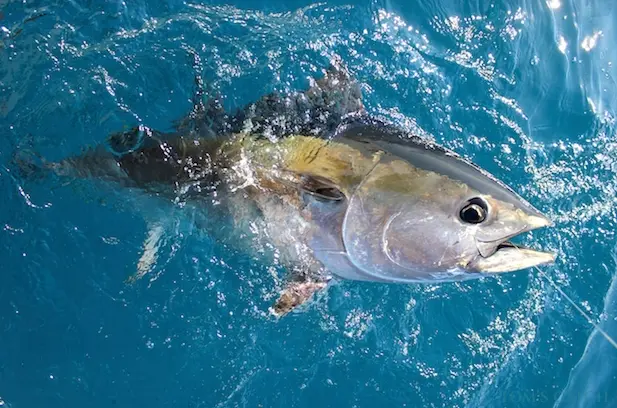Fishing for tuna is an exhilarating and challenging endeavor that requires the right gear to ensure success. One of the critical components of your fishing setup is the rod. Choosing the right size rod for tuna fishing can make a significant difference in your ability to land these powerful and hard-fighting giants of the sea.
In this guide, we’ll explore the factors that influence your choice of rod size for tuna fishing and provide valuable insights to help you make an informed decision.
Understanding Tuna Fishing
Tuna are renowned for their strength and speed, making them a highly sought-after target for anglers worldwide. These apex predators can grow to impressive sizes, from the relatively smaller skipjack tuna to the massive bluefin tuna, which can weigh hundreds of pounds. When it comes to fishing for tuna, having the right equipment is crucial.
Factors to Consider When Choosing a Rod Size
Selecting the appropriate rod size for tuna fishing involves considering several key factors:
1. Tuna Species and Size
Different tuna species vary in size and behavior. Bluefin tuna, for example, are known for their immense strength and can put up a ferocious fight. On the other hand, yellowfin tuna are also powerful but might not require as heavy-duty gear. Understanding the specific species you’re targeting and their average size will help you determine the rod size that can handle their strength.
2. Fishing Technique
The fishing technique you plan to employ plays a significant role in rod selection. Tuna can be caught using various methods such as trolling, casting, or live bait fishing. Each technique demands a different rod action and power. Trolling may require a more flexible rod to handle the constant movement of the bait, while casting might benefit from a stiffer rod for longer casts.
3. Line Strength
The strength of your fishing line is directly related to the rod size. Heavier lines require rods with greater backbone and power to handle the strain of battling a large tuna. Conversely, lighter lines can be used with lighter rods, although this might limit the size of tuna you can target.
4. Rod Length
The length of your rod impacts casting distance, leverage, and overall control. Longer rods generally provide greater casting distance, which can be advantageous when targeting tuna that may be wary of approaching boats. Shorter rods offer increased leverage when reeling in a big fish, helping you exert more force during the fight.
5. Personal Preference
Ultimately, your personal preferences and fishing style should also influence your rod size choice. Some anglers prefer a more challenging fight and opt for lighter gear, while others prioritize landing the tuna efficiently and choose heavier setups.
Recommended Rod Sizes for Tuna Fishing
Considering the factors mentioned above, here are some general recommendations for rod sizes based on tuna species and fishing techniques:
- Bluefin Tuna: For targeting large bluefin tuna, a heavy-duty rod with a length of 6.5 to 8 feet and a line rating of 80 to 130 pounds is often recommended. This will provide the necessary strength to handle these formidable giants.
- Yellowfin Tuna: A versatile choice for yellowfin tuna fishing is a rod with a length of 6 to 7.5 feet and a line rating of 50 to 100 pounds. This range allows you to effectively target a variety of sizes using different techniques.
- Albacore Tuna: Albacore tuna can be pursued with a rod length of 5.5 to 7 feet and a line rating of 20 to 50 pounds, suitable for trolling, casting, or live bait fishing.
Remember that these are general guidelines, and there is no one-size-fits-all answer. Your specific preferences, fishing conditions, and the gear you have available should all be taken into account.
Conclusion about Choosing the Right Rod Size for Tuna Fishing
Selecting the right size rod for tuna fishing is a crucial step in ensuring a successful and enjoyable angling experience. By considering factors such as the tuna species you’re targeting, your preferred fishing technique, line strength, rod length, and personal preferences, you can make an informed decision that enhances your chances of landing these incredible fish.
As you venture into the world of tuna fishing, remember that the right rod size can be the key to unlocking the thrill of battling these powerful oceanic predators.
FAQs about Choosing the Right Rod Size for Tuna Fishing
1. Why is the rod size important for tuna fishing?
The rod size is crucial because it determines how well you can handle the strength and fight of tuna. Tuna are known for their powerful runs and vigorous battles, and a properly sized rod will give you the control and leverage needed to land these impressive fish.
2. How do I determine the appropriate rod length for tuna fishing?
The rod length depends on your fishing technique and personal preference. Longer rods generally offer increased casting distance, while shorter rods provide better leverage during the fight. Consider where you’ll be fishing, the boat size, and how you plan to reel in the tuna when deciding on the rod length.
3. What is the significance of rod action in tuna fishing?
Rod action refers to how much the rod bends when pressure is applied to the tip. Fast-action rods bend primarily in the upper third, providing more power for casting and fighting larger fish. Moderate or slow-action rods bend more uniformly along their length and are often used for smaller fish. Choose a rod action that complements your preferred fishing technique and the size of tuna you’re targeting.
4. Should I use a heavy or light rod for tuna fishing?
The rod’s power, often referred to as its “weight,” should be matched to the size of tuna you’re targeting and your preferred fishing style. Heavy rods are suitable for larger tuna species like bluefin, providing the necessary backbone to handle their strength. Lighter rods can be used for smaller tuna, offering a more challenging fight.
5. Can I use the same rod for different tuna species?
While it’s possible to use the same rod for different species, it’s essential to choose a versatile option that can handle a range of sizes. A medium to heavy rod with a suitable line rating can work well for targeting different tuna species, allowing you to adapt to various fishing conditions.
6. What type of line should I use with my chosen rod size?
The fishing line you use should match the rod’s specifications. Heavier rods can handle thicker lines with higher pound test ratings, while lighter rods require lighter lines. Ensure your line complements the rod’s power and action to optimize your fishing setup.
7. Can I use a spinning reel or a baitcasting reel for tuna fishing?
Both spinning and baitcasting reels can be used for tuna fishing, depending on your preference and fishing technique. Spinning reels are generally more user-friendly and versatile, while baitcasting reels offer greater casting accuracy and control for specific techniques like vertical jigging.
8. Do I need specialized tackle for tuna fishing, or can I use my existing gear?
While it’s possible to adapt existing gear for tuna fishing, specialized tackle designed for saltwater and heavy-duty applications will enhance your success and enjoyment. Tuna fishing can subject your gear to significant stress, so investing in quality equipment designed for the task is recommended.
9. Are there any specific rod brands that are well-suited for tuna fishing?
Several reputable fishing rod brands offer models specifically designed for tuna fishing. Some popular brands known for their quality and durability in saltwater fishing include Shimano, Penn, Daiwa, and Okuma. Research and reviews can help you identify the best options within your budget.
10. What’s the most important thing to remember when selecting a rod size for tuna fishing?
The most important thing to remember is that there’s no one-size-fits-all answer. Your choice of rod size should be tailored to your fishing preferences, the tuna species you’re targeting, the fishing techniques you plan to use, and the fishing conditions you’ll encounter. Taking the time to understand these factors will lead to a more enjoyable and successful tuna fishing experience.
As you embark on your tuna fishing journey, keep these FAQs in mind to guide you toward selecting the ideal rod size that aligns with your goals and preferences. With the right rod in hand, you’ll be better equipped to tackle the challenges and rewards that come with pursuing these majestic ocean predators.

